With my fourth round-the-world ticket in hand, I left Hong Kong on December 3 with 25 kg of checked-in luggage for a seven-month journey. My first stop is Australia as my nephew is getting married in Sydney in mid-December. Then I shall be in South and Central America from Christmas Day to early June and be back in Hong Kong in July.
Introduction
A round-the-world ticket valid for a year covering 16 cities in four continents is an economic way for adventure. I brought my first round-the-world ticket in 1979 which cost about HK$20,000. Today I pay HK$32,000 for the same ticket (just over HK$40,000 including taxes). Fantastic value!
I am a happy wanderer and have never done much preparation for any journey. But this time is different.
- I first took ten private lessons in order to learn some basic Spanish.
- With a bad experience in Romania earlier this year when I could not get money with my card, I get myself two debit cards to make sure I would not be out of money.
- I sort out bill payments in the next few months.
- Lawrence, my brother gave me a smart phone. I can now reach my family and friends via Whats App, Viber, Skype and email free of charge provided there is free Wifi!
- I get a large stock of high-blood pressure pills and anti-malaria medication. Amy and SH who have kindly offered to take care of my three tortoises and fish came to take my pets home.
- I try hard to find travel insurance covering the entire period without success. I pay eventually over HK$3,000 for a 6-month coverage.
- My handy man has kindly agreed to come to water my plants.
Though I shall be away for only seven months, I have to put away almost everything in my flat. I was exhausted when I left my flat for the airport.
There are too many scaring stories about travelling in South America. Bertha and my girlfriends made sure I had excellent home cooking the day before my departure. Everyone wishes me a safe journey and I hope so too!
3 Days in South Australia
December 3 Tuesday: Hong Kong – Adelaide, South Australia (GMT + 10.5)
I have been to all the states and territories in Australia except South Australia. Cathay Pacific Airways now flies direct to Adelaide and I happily set foot on Adelaide known for its German flavour after a 9-hour flight. To mark the beginning of my trip, Cathay Pacific Airways offered to upgrade me to the Premium Economy class at a cost of HK$1200. The money is worth spending: I had a pleasant and comfortable flight.
I did not realise that the Ashes cricket series would be staged in Adelaide starting on December 5. Accommodation is a big problem. I booked a room at Mecure Grosvenor Hotel at the North Terrace just before leaving Hong Kong. When I checked in, I asked the receptionist for two more nights only to find out that the hotel was fully booked. She advised me to avoid hotels which would be charging $200 to 400 a room (A$1 to about US90 cents). I should simply look for a bed in a hostel. What an exciting beginning of my trip!
As soon as I left my luggage in my room, I went out for a bed-hunting for the next two days. I managed to grab the last bed in a hostel for $30 a night (The price gone up to $50 two nights later).
I signed with relief after having sorting out the accommodation problem and started to think sight-seeing. Where should I begin with my exploration of Adelaide? Hahndorf, the first settlement in Australia specifically planned for non-British immigrants naturally came to my mind.
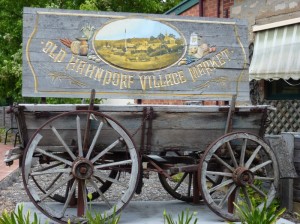 |
In 1838, three ships of immigrants of staunch Lutheran beliefs who escaped religious persecution from the eastern provinces of Prussia arrived in South Australia. The majority of Hahndorf’s 54 founding families were among the 188 passengers aboard the ‘Zebra’. The ship’s master, Captain Dirk Hahn helped his passengers to settle together as a community. Hence the town has been named after him.
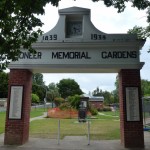 |
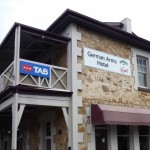 |
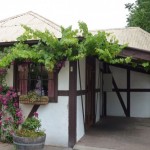 |
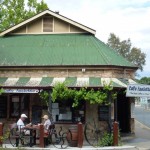 |
Hahndorf is the oldest as well as the most visited German town in Australia. The 50-minute bus ride on winding road is indeed a pleasant surprise. The fare is cheap costing only $3.1. Nestling in Adelaide Hills Hahndorf is quaint and charming with strong Germanic influences. As it’s Tuesday, the place is lovely and quiet. I spent over an hour wandering around soaking in the Germanic ambience. The place is so different with traditional stone houses, red gum barns, characteristic fachwerk (half timbered) Germanic houses and manicured lawns and gardens. The main street is lined with eateries (German pubs, cafés, restaurants, bakeries and ice-cream shops), butcher shops as well as galleries and souvenir shops. It is touristic but the elegant Germanic ambience is enchanting and unique in Australia.
It was almost 6pm when I was back in downtown Adelaide. I strolled along the Rundle Street looking at old buildings. I was hungry and wanted something Australian but cheap. The best choice (as well as the only one) is a beef burger and chips and a pint of beer for only $9.9 in an old style hotel. The beef burger is gigantic: this explains the problem of obesity in Australia!
My original plan was to join a 2-day tour to Kangaroo Island. It was sold out though a one-day trip costing over A$250 was available. I hate rushing and booked the last place on a leisure Barossa Valley experience tour for $93 the following day. I was dead tired and slept like a log for nine hours.
December 4 Wednesday: Barossa Valley
South Australia accounts for about half of the wine production in Australia. A wine-tasting trip to Barossa Valley is a ‘must-do’ for wine-lovers and visitors to Adelaide. As a professional tourist, I took a winery tour without second thought.
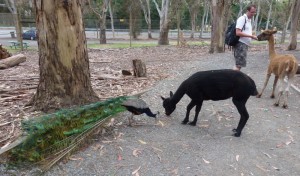 |
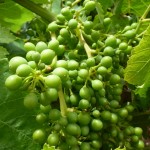 |
The scenic drive through the Adelaide Hills, Torrens Gorge, Eden Valley and Barossa Valley is worth taking on its own right. We had a very busy day hopping in and out of the minibus. The Big Rocking Horse toy factory which boosts the world’s biggest rocking horse was the first stop of the day. I fed wallabies, emus, sheep, alpacas and peacocks in the wildlife park run by the factory. At the second stop in Angaston, home of Australia’s famous Angas Park Dried Fruits, I brought some cranberries.
The day’s first stop in Barossa Valley was the Wolf Blass Winery which has a posh visitor center. The receptionist arranged us to taste seven bottles of wine. I could not recall much about what I had. But her professionalism and flair are remarkable. The KaesIer Winery housed in an old stone barn like structure does not leave much impression on me.
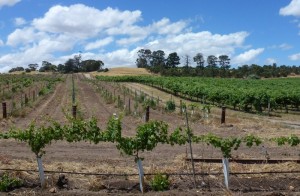 |
After a nice lunch in the Nuriootpa Vine Inn, we arrived at Krondorf which affords fantastic views over the vine-striped hills of Tanunda. The Grant Burge wine especially the vintage old port is excellent. But I enjoy the Kies Family Wines most. This boutique winery produces only 3,600 bottles a year and the owner serving us the wine is charming and friendly. Here I had my first taste of sparkling red wine, frozen Muscat and icy port.
On the drive back to Adelaide, we had a 20-minute stop at the Whispering Wall, which is national engineering landmark. The wall is proper name is Barossa Dam of the old reservoir. Standing at one end of the wall of the dam, I can hear the whisper as well as singing of another person at the other end. Amazing!
I had a great day. The weather was fabulous and our guide cum driver is funny and knowledgeable. He has told us a lot about how the German emigrants came to settle in the area, the short history of wine-making in the region and the major wineries in Barossa Valley. I like wine and find the tasting of some 20 types of wine within several hours quite an experience. I remained sober at the end of my trip! But the sight of industrial production of wine on a large scale and transportation of wine by oil-tanker like vehicles ruins my romantic view of wine-production. I prefer the landscape of vineyards and the traditional wineries in Europe!
I checked in the hostel on King William Street after the trip. The hostel with over 100 beds was full. The place was full of German young travellers and some old British cricket fans that had come for the Ashes matches. I shared a room with five young German girls on working holiday in Australia.
The hostel receptionist suggested me go to China Town and Gouger Street for dinner. This small and neat China Town is located right next to the Central Market. I had excellent fried rice with spicy mutton in Xinjiang style for $10. The portion was so generous that I had to keep a third for breakfast.
Phone calls and internet service are expensive in Australia and free Wifi is not common. I was therefore taken by surprise when a shop-keeper tipped me off about free Wifi in China Town.
December 5 Thursday: Adelaide
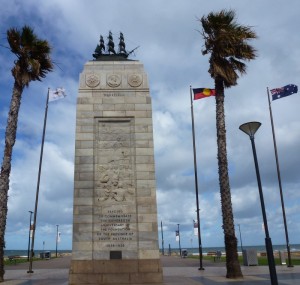 |
I brought a day pass for less than $10 and took a tram to the quaint suburb of Glenelg on the coast. It is commercial but not as spoilt as the Gold Coast in Queensland. It was so cold, windy and wet that I could not stop shivering. By 10am, I had enough and took the tram back to town.
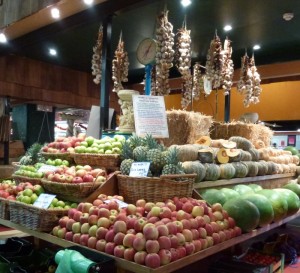 |
I love markets. So my next stop was the Central Market which stalls are filled with fresh fish, meat, fruits and vegetables. I find the strong Italian and German flavour appealing. I had a nice cooked breakfast and a chocolate for $15 (not cheap) in an Italian café.
 |
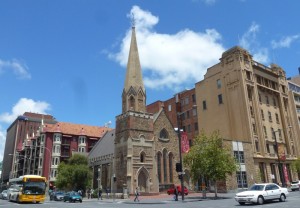 |
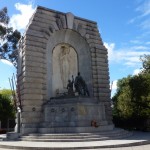 It’s time for a stroll to soak in Adelaide’s history and culture. I started my walk on North Terrace which has a mix of old and modern buildings plus several memorials, statues and plaques. I like the University of Adelaide cluster most. The Art Gallery is worth visiting and I also joined an hour-long guided tour on a special exhibition on India which I have visited many times. Though I have seen many exquisite exhibits in other museums, I still enjoy the tour and am impressed by the guide’s passion and knowledge (she is a volunteer). I listened patiently and have learnt something new about Jainism. There is also a good collection of Australian Indigenous art.
It’s time for a stroll to soak in Adelaide’s history and culture. I started my walk on North Terrace which has a mix of old and modern buildings plus several memorials, statues and plaques. I like the University of Adelaide cluster most. The Art Gallery is worth visiting and I also joined an hour-long guided tour on a special exhibition on India which I have visited many times. Though I have seen many exquisite exhibits in other museums, I still enjoy the tour and am impressed by the guide’s passion and knowledge (she is a volunteer). I listened patiently and have learnt something new about Jainism. There is also a good collection of Australian Indigenous art.
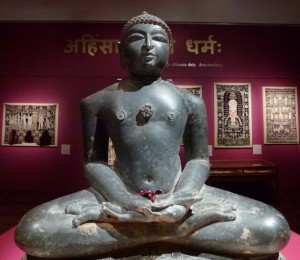 |
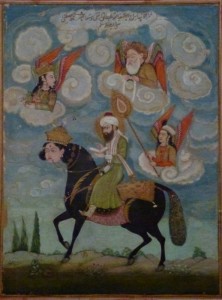 |
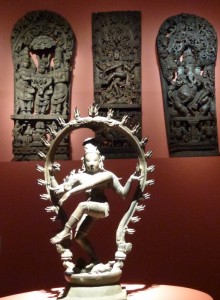 |
 |
I spent another hour at the National South Australia Museum which also has a large collection on the Aboriginals. I would like to visit the Migration Museum next door. But it was too late to get in.
I then took a train to the Outer Harbour and planned to hop off at Port Adelaide. But the area along the railway line looks dull as compared with the up-scale suburb along the tramway to Glenelg. Apart from a passenger terminal, there is nothing at all at the Outer Harbour. I was annoyed by the disgusting behavior of three teenage boys in the train who shouted at two monks in yellow robe (apparently from SE Asia) telling them to ‘take off the fxxxing robe’. I had once been told off by a few teenagers to go home during a trip to Cairns ten years ago. Is racism a problem here? I did not get off at Port Adelaide and headed back to the city.
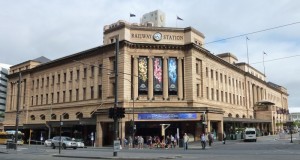 From the railway station, I went straight to the Casino. I am not a gambler but I like to try my luck. I walked past an old lady who had just hit the jackpot winning over $7,800 on a slot machine. I spent 20 minutes on a one-arm-bandit machine before squandering away $20.
From the railway station, I went straight to the Casino. I am not a gambler but I like to try my luck. I walked past an old lady who had just hit the jackpot winning over $7,800 on a slot machine. I spent 20 minutes on a one-arm-bandit machine before squandering away $20.
As the cricket matches are held in Adelaide Oval across the river, I felt I should go over to take a look. But I got there too late and the match was over! I felt cold and returned to the hostel before dark ending my first visit to Adelaide. My overall impression of the city is pleasant with a European feel.
December 6 Friday: Adelaide – Alice Springs (GMT+9)
I enjoyed the 2-hour scenic flight to Alice Springs! The landscape of the Red Centre is mesmerizing with all hues of red and eerie white salt lakes. But the landscape turns greener and greener when approaching Alice Springs. Recent rainfall has transformed the area into an oasis. I stayed at Annie’s Place and booked a 3-day Uluru camping tour with Emu Run for $350.
3 Days in the Red Centre: December 7 – 9 (Saturday – Monday)
I am not a stranger to the Red Centre. I first visited the Northern Territory in April 2002 when carrying out a research on the management of the Uluru-Kata Tjuta National Park as a World Heritage Site. I began my trip in Darwin and took four consecutive overland 3-day tours to Kakadu National Park, from Darwin to Alice Springs; to Kings Canyon and Uluru and finally from Alice Springs to Cairns. I find the outback, the Red Centre and the rainforest awesome and fascinating.
Day 1 – Maria, a Kiwi, is our tour guide cum driver. There were 13 passengers including two families of four (one from Sydney and another from Korea), Cici and Karen (two Chinese PhD students from Canberra), Anna from Demark and Natasha from Ukraine. It took almost six hours to reach Uluru which is about 450km from Alice Springs. We had several brief stops to visit a camel farm, Mt Ebenezer Roadhouse, Mt Connor (a table-topped mountain, three times the size of Uluru) Lookout and Curtain Springs Roadhouse.
It was getting hotter and hotter. By the time we reached the national park, it must be over 38°C. We had a sandwich lunch and jumped into a tiny pool to cool down. We spent an hour in the Cultural Centre which provides information on the Aboriginal people and their culture.
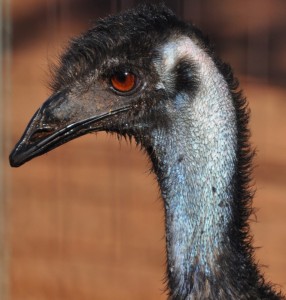 |
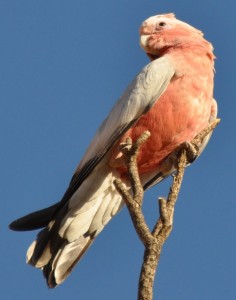 |
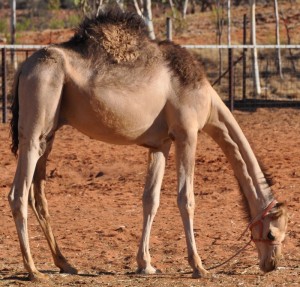 |
Uluru (Ayers Rock) and Kata-Tjuta (Olgas), both icons of Australia, are sacred for the Aboriginal people. Opened in 1985, the national park is jointly managed by the Anangu Traditional Owners and Park Australia. For years, visitors have been advised to respect the local culture and not to climb the sacred rock. Instead of climbing, the park management has been promoting the 10-km base walk. In any case, the climb to the top is very steep and particularly dangerous under intense heat. It is said that 36 climbers have died so far and the climb might be prohibited once the dead toll hits 40.
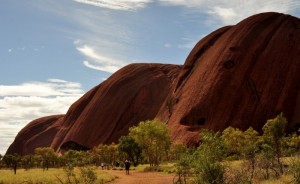 |
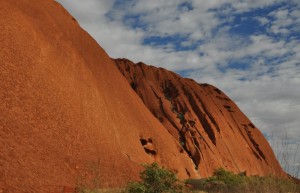 |
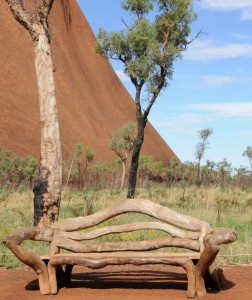 |
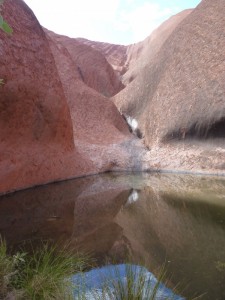 |
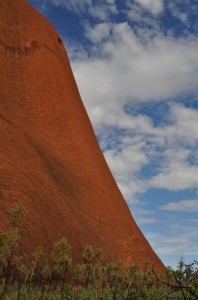 |
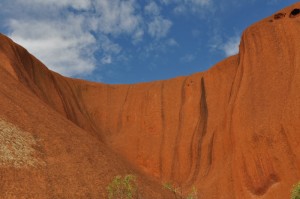 |
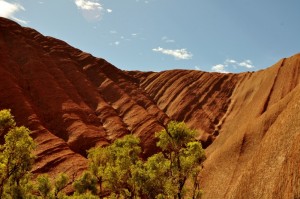 |
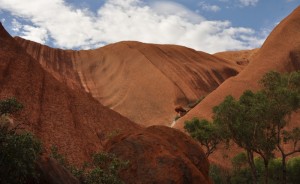 |
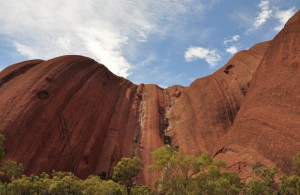 |
As it was a hot day, even part of the base walk was closed. We spent over an hour on the Mutijulu Waterhole walk. The waterhole is magical and the rock itself is an extraordinary piece of work of unearthly beauty. I find the ever changing hues, lines and shape of this monolithic rock magical. Even without knowing the culture of the Aboriginal people, any visitor will be struck by its beauty and magnificence. Maria took us back to the campsite for another dip before sunset viewing where we had bubbling wine and snacks. We celebrated Natasha’s birthday. Unfortunately, it was cloudy and we did not see a postcard sunset. (But I had seen a gorgeous one last time and hope to dig up the photos on my return to HK next July)
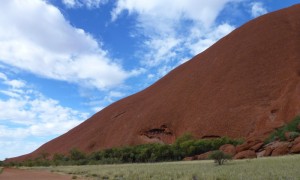 |
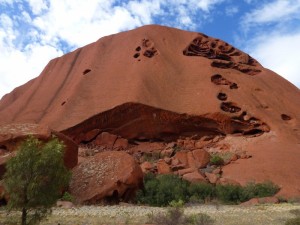 |
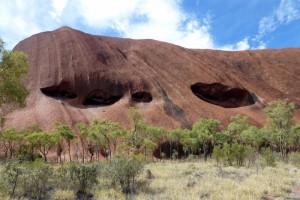 |
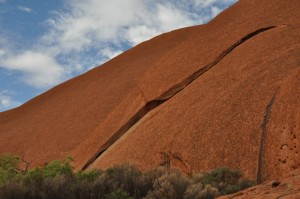 |
Sleeping in a swag under the starry night is a typical outback experience! It began to cool down and I had a comfortable sleep in a swag despite the loud noises coming from the pool side. It was cloudy and I missed the spectacular starry sky that I first saw in the outback in 2002.


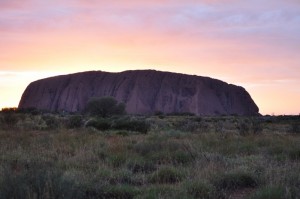
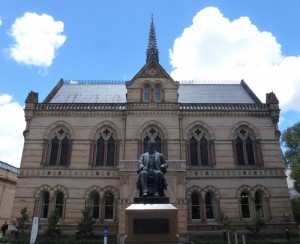
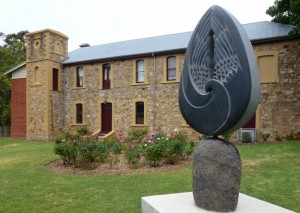
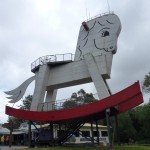
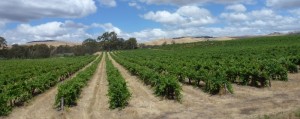
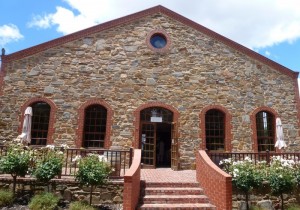
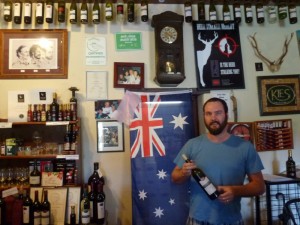
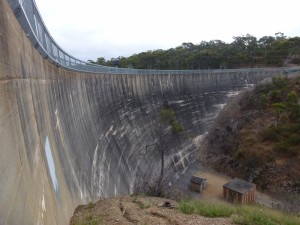
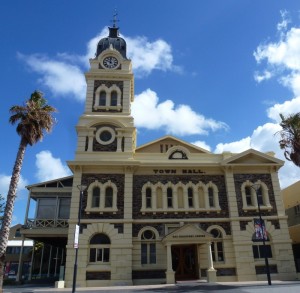
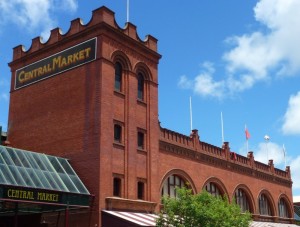
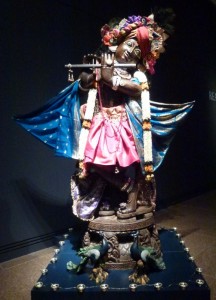
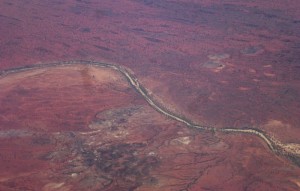
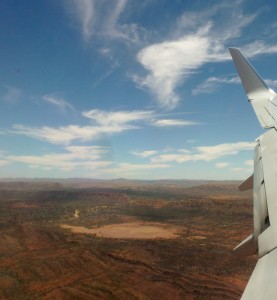
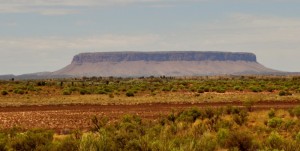
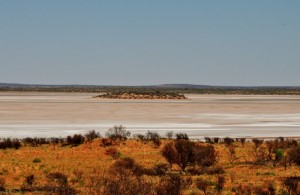
hi, sarah
you start your trip again
be safe and happy around you in the trip
all the best^^
Hi, Sarah,
I will be in S America in Feb/Mar 2014 too. I am going to take the Antarctica cruise(7 days), followed by Patagonia (10 days) and Easter Island (4 days). This tour is arranged by a friend (keen photographer) with over 20 participants. Will our paths cross ?
Maureen
PS I hope one day I can go to Ayers Rock which I hv never seen in person.
Dear Sarah,
I really admire you! There is no way for me to do something similar for the rest of my life. Really enjoyed your great dinner with other friends before your departure.
When you are in South America, please always have your camera ready as the frequency of seeing UFOs there is very very high, compared with other parts of the world.
When you see a UFO, even if you don’t have enough time to take pictures (preferably video), please record the exact date and time (local time) and the duration of the sighting. More important, the following information is necessary:
a) shape, colour and size of the UFO;
b) the weather, day or night, with sun light or cloudy;
c) speed and possible height of the UFO;
d) direction of flight (this is extremely important) as your information may be used to cross check with others in the future;
e) any other witnesses by the side of you?
Best of luck, Merry Christmas, Happy New Year and then Happy Chinese New Year to you.
Albert